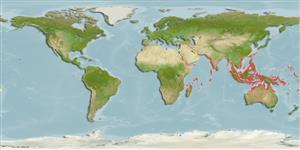>
Acanthuriformes (Surgeonfishes) >
Siganidae (Rabbitfishes)
Etymology: Siganus: Latin, siganus = a fish, rabbit fish; by the similarity of the nose (Ref. 45335).
More on author: Linnaeus.
Environment: milieu / climate zone / depth range / distribution range
Ecologia
marinhas; estuarina associadas(os) a recifes; oceanódromo (Ref. 51243); intervalo de profundidade 0 - 20 m (Ref. 90102), usually 2 - 20 m (Ref. 27115). Tropical; 25°C - 28°C (Ref. 27115); 30°N - 20°S
Indo-Pacific: Persian Gulf, Gulf of Oman, Pakistan, India, Sri Lanka, Burma, Andaman Islands, Thailand, Viet Nam, southern China, Malaysia, Indonesia, Philippines, Australia, New Guinea, Vanuatu and New Caledonia. Records for the Ryukyu and Ogasawara Islands could be based on strays (Ref. 9813).
Tamanho / Peso / Idade
Maturity: Lm ? range ? - ? cm
Max length : 53.0 cm TL macho/indeterminado; (Ref. 9710); common length : 30.0 cm TL macho/indeterminado; (Ref. 9813)
Espinhos dorsais (total) : 13; Raios dorsais moles (total) : 10; Espinhos anais: 7; Raios anais moles: 9; Vértebras: 13. Body bronze above, white on belly and thorax; iris light brown; pectoral fins hyaline, pelvic fins white. Slender and pungent dorsal spines; anal spines stout. Preopercular angle 78°-92°. Strong scales cover cheeks. Midline of thorax scaled but not pelvic ridges. Broad-based triangular flap of anterior nostril reaching half way to posterior nostril in juveniles, reducing to a small crescent with age.
Occurs in small schools of up to 10 individuals or so, in shallow coastal waters, brackish lagoons and rocky or coral reefs. Feeds on algae attached to the substrate and on floating algal fragments. Found resting in midwater at depths of 2 to 6 m when not feeding. Marketed fresh (Ref. 9813, 48637). Maximum depth from Ref. 027115.
Life cycle and mating behavior
Maturidade | Reprodução | Desova | Ovos | Fecundidade | Larvas
Woodland, D.J., 1990. Revision of the fish family Siganidae with descriptions of two new species and comments on distribution and biology. Indo-Pac. Fish. (19):136 p. (Ref. 1419)
Categoria na Lista Vermelha da IUCN (Ref. 130435: Version 2024-1)
Utilização humana
Pescarias: espécies comerciais; Aquário: Espécies comerciais
Ferramentas
Relatórios especiais
Descarregue XML
Fontes da internet
Estimates based on models
Preferred temperature (Ref.
123201): 25.5 - 29.1, mean 28.3 °C (based on 1152 cells).
Phylogenetic diversity index (Ref.
82804): PD
50 = 0.5000 [Uniqueness, from 0.5 = low to 2.0 = high].
Bayesian length-weight: a=0.01445 (0.00896 - 0.02332), b=3.06 (2.93 - 3.19), in cm total length, based on LWR estimates for this species & Genus-body shape (Ref.
93245).
Nível Trófico (Ref.
69278): 2.4 ±0.08 se; based on food items.
Resiliência (Ref.
120179): Médio, tempo mínimo de duplicação da população 1,4 - 4,4 anos (Preliminary K or Fecundity.).
Fishing Vulnerability (Ref.
59153): Moderate vulnerability (41 of 100).
Nutrients (Ref.
124155): Calcium = 26.6 [12.9, 59.8] mg/100g; Iron = 0.564 [0.265, 1.268] mg/100g; Protein = 19 [18, 20] %; Omega3 = 0.102 [0.053, 0.199] g/100g; Selenium = 20 [8, 50] μg/100g; VitaminA = 27.5 [7.2, 104.7] μg/100g; Zinc = 1.26 [0.50, 2.78] mg/100g (wet weight);
